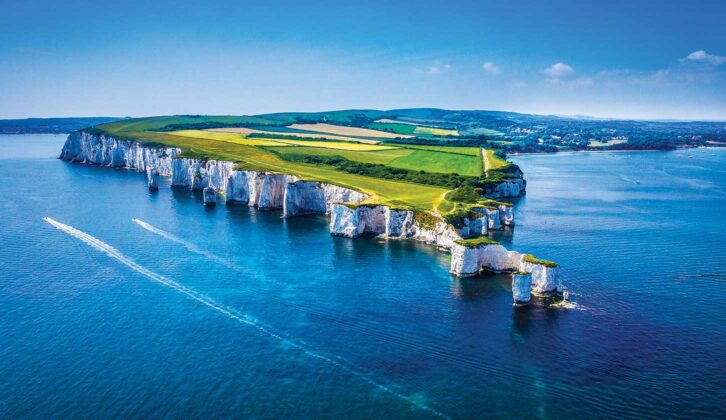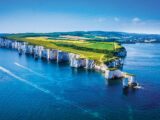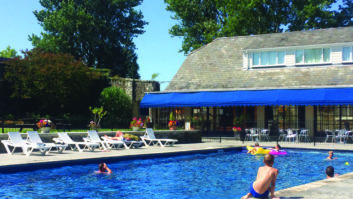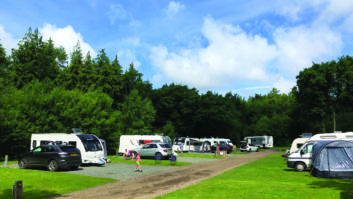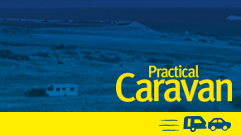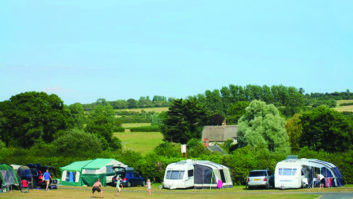The Isle of Purbeck is a truly stunning location if you are planning to take a break by the sea. It offers glorious coastal paths, splendid scenery, caves, WWII defences and an abundance of adventure activities, from rock climbing to coasteering.
Incidentally, this gorgeous part of Dorset is a peninsula, and is referred to as an isle because it’s bordered on three sides by the sea and on the remaining side by the beautiful River Frome.
The best caravan parks in Dorset will be well placed for exploring the many delightful sights of the region, and that was the case with where we chose to stay. My wife, Suzy, and I visited last summer, staying at Downshay Farm Caravan Site, one of Dorset’s dog friendly caravan parks, where we quickly found our pitch before heading into nearby Swanage.
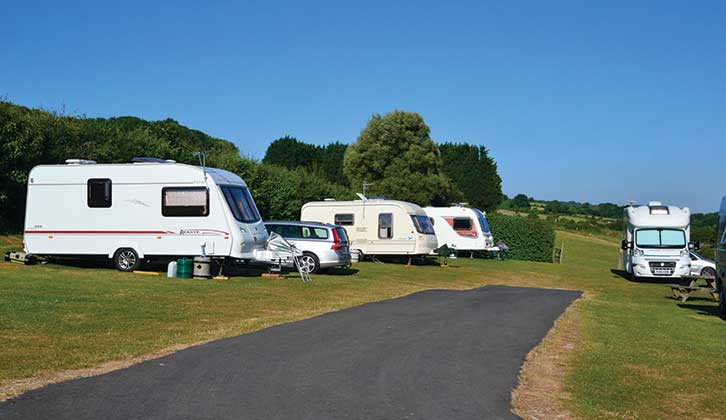
The sun was shining and people were swimming and playing with inflatables in the sea. We parked near the seafront and walked to Peveril Point, a viewpoint on the headland. We could see numerous boats bobbing about in the bay, jetskiers and amazing coastal scenery.
There’s a Coastguard Lookout Station at Peveril Point. The Coastguard reports incidents to the RNLI, keeps shipping records, and responds to radio requests from nearby vessels asking for weather reports or information on local facilities and any potential hazards.
Seaside resort
After walking along the coastal footpath for some time, we decided to take a look around Swanage town centre, with its abundance of interesting shops, including clothing, antique and souvenir shops.
We stocked up on food before returning to the campsite (see: the best caravan sites if you’re wondering where to go next) for a peaceful evening.
The following day, we went to Studland Bay – where we stumbled across a naturist colony on part of Knoll Beach. This is a 900m stretch of coastline, clearly marked with green-topped posts and signs.
Suzy pondered about joining them, but I’d rather have a patchy tan than get my kit off in front of strangers!
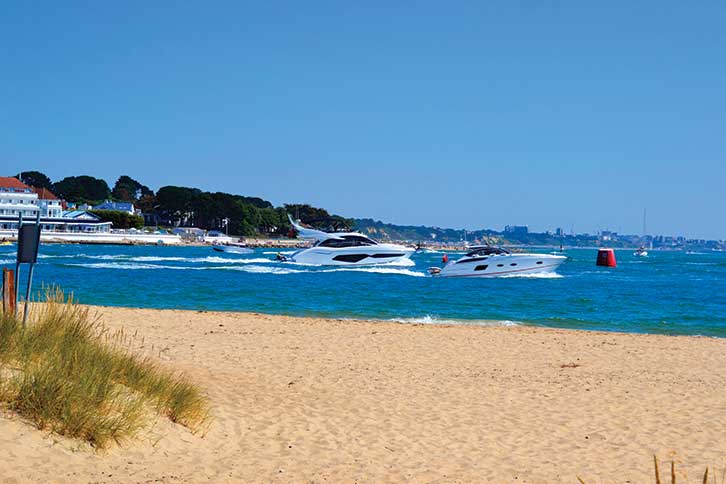
We finally reached Shell Beach, which was populated by lots of families (with their clothes on!). As we sat on the sand to relax, we watched speedboats zip past, glorious yachts, and a car ferry carrying people between Sandbanks and Studland Bay. A City Cruises Poole passenger ferry sailed serenely past in the distance, and we also spotted a Border Force craft, which was clearly out on its regular patrol.
After resting for a time on the beach, we followed a route through the nature reserve adjacent to the sands, which took us across dunes and through carpets of heather.
We saw deer running in the distance, and even spied a few lizards crossing the sandy footpaths in front of us.
Once we got back to the car, we decided to drive further along the coast to Middle Beach, where we enjoyed a bite to eat at a beachfront café overlooking the sea.
Suzy went rowing in her dinghy, while I relaxed on the sand, sunning myself.
We watched the world pass by for a few hours, until we felt we’d had enough sun and retired to the campsite in time for tea.
Old Harry Rocks
The next day, we walked along another stretch of the coastal path to Old Harry Rocks, where glorious rock formations rise out of the water. Among them are chalk arches and spires – canoeists were rowing around them. Speedboats, motorboats, waterskis and paddle boards were all out on the water around Old Harry Rocks, and the clifftops were adorned with the most beautiful wildflowers. We spent a lot of time here, simply enjoying the views.
Another charming place that we visited was Durlston Castle, a 19th-century house and garden set in Durlston Country Park. It’s free to go inside and there’s a cafe, an art exhibition and a shop.
From here, the South West Coast Path takes you to Anvil Point Lighthouse. You can view the sea caves, once the entrances to a quarry, and keep an eye out for birds of prey hovering above the rocks.
We saw a huge range of butterflies and moths perched on the wildflowers, and there were baby kestrels in a nest on the edge of the cliff, and gannets in the waters below. This area is a haven for wildlife.
The following day, we visited Lulworth and strolled around the pretty village, lined with small shops and cafés, to the glorious bay, carved out by the sea over many thousands of years. There’s an exhibition in the visitor centre, which explores the history of the various rock formations and the different types of rock that have formed this very special landscape.
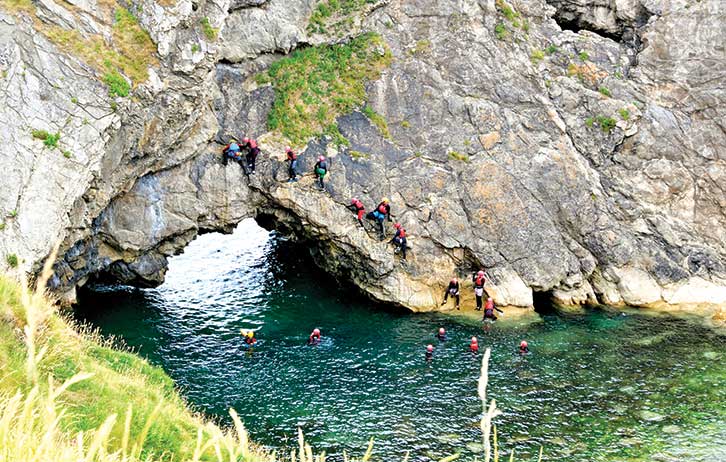
Walking along the pebble beach around Lulworth Cove, we climbed the headland and admired the wonderful views. We could see canoeists paddling through the arches – it looked absolutely idyllic.
Reptiles and birdlife
We spent a fabulous afternoon at RSPB Arne, near Wareham, in search of glorious landscapes and wildlife. This is home to Britain’s six reptile species, and we were lucky enough to spot one – a slow worm on the path – which I almost trod on!
Despite looking for other reptiles, we didn’t see any and the staff reckoned the weather was too hot, even for reptiles.
On a more moderate day, it’s common to see lizards and grass snakes. The reserve also hosts wading birds and water voles; we spotted a few egrets, but sadly, no voles.
Before heading back to camp for the evening, we visited Wareham town centre and walked beside the River Frome. It’s a lovely location with a delightful riverside pub and there were many beautiful yachts and canal boats moored on the water.
The Old Granary, the pub right by the river, is a good place to stop for a drink.
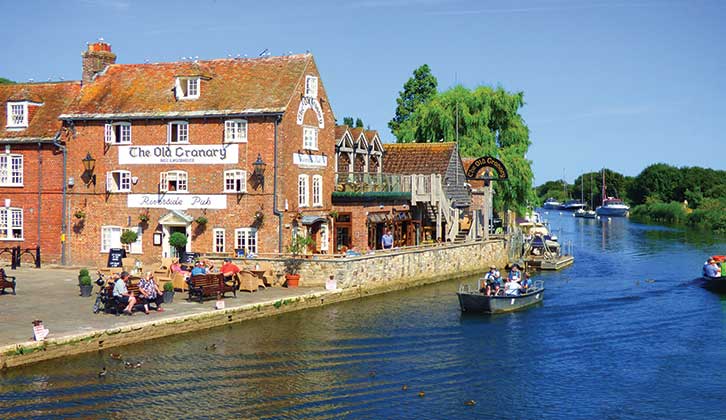
Ghost village
Next day, we made a leisurely start to enjoy a walk from Kimmeridge. The visitor centre has a small aquarium, information boards and a shop. We walked for an hour, taking in the beautiful scenery.
After a break for lunch, we spent the afternoon at the abandoned village of Tyneham, a strange and rather ghostly place. This thriving village was abandoned in 1943 because of military training activities that made it dangerous for the residents to stay. It was evacuated by the MOD and they were never allowed to return home.
Animal-lovers will also enjoy visiting Margaret Green Animal Rescue, a sanctuary offering homes to neglected and abandoned ponies, goats, sheep, pigs, donkeys, ducks, geese, chickens, cats, rabbits and even guinea pigs.
Heritage railway
Our holiday would not have been complete without a trip on the local heritage rail line, so we took a Swanage Railway train to see Corfe Castle, catching the first steam train from Harman’s Cross station, a short walk from the campsite. The carriages have seen better days but are still going strong, and after a scenic 10-minute ride through some beautiful countryside, we eventually reached Corfe Castle Station.
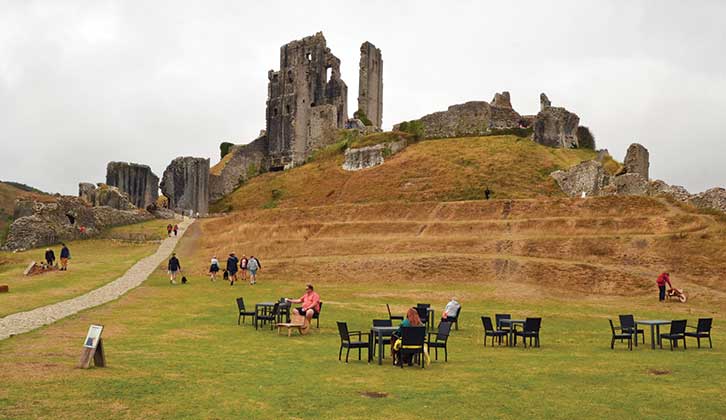
The castle itself is a short walk from the station. This iconic hilltop ruin has a long and chequered history, described on the information boards in the grounds. It has been a home, a prison and a fortress.
We took in the spectacular views from the castle ramparts, then walked around the lovely village, before taking the train back to Harman’s Cross in time for lunch. We returned to the main (non-naturist) part of Knoll Beach for the afternoon, which was busy, perhaps because there’s a shop, café, boat hire and other facilities here.
We relaxed in the sun, paddled in the sea and were entertained while watching the banana boat taking people out on the water. They all fell off!
On our final day, we got an extension to our departure time so we could take one last look at Shell Bay, our favourite beach. From here, you can watch the ferry going back and forth to Sandbanks, see the boats sailing past and paddle in the sea. The ice cream boat was selling ices to people in the shallows, a man was flying kites, and there were dogs playing in the water.
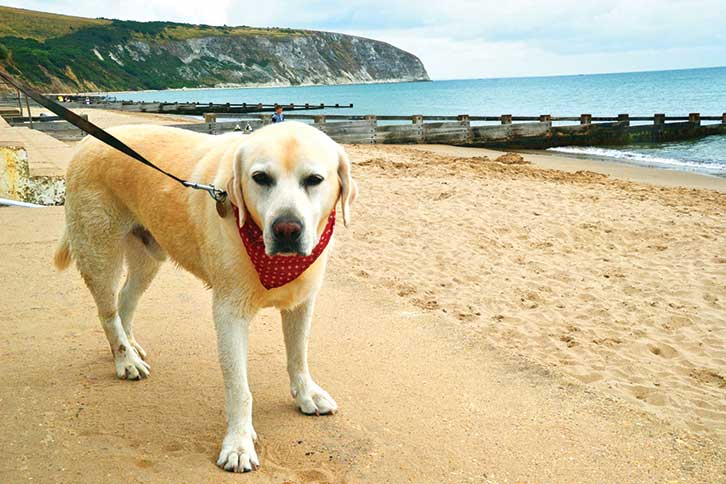
I went for a paddle in the sea, spotting pipefish, shrimp and a shoal of tiny, almost translucent fish. Blackheaded gulls were diving for other fish in deeper water.
It really was a lovely holiday, and the Isle of Purbeck is a place that we would certainly enjoy visiting again.
If you’re looking for some more touring inspiration, see how Elaine and Joe Ormerod got on when they set off on a tour to Newark to find out about the region’s turbulent history. You can also find out how Nigel Hutson got on when exploring Calderdale, an area with a fascinating past.
Planning a tour to the Isle of Purbeck
Where we stayed to explore the Isle of Purbeck
Downshay Farm
Haycrafts Lane, Swanage BH19 3EB, 01929 480 316, downshayfarm.co.uk
- Open: 1 April to 1 November
- Pitches: 12
- Charges: £25-£27
This site has unisex facilities, with showers and toilets in a converted outhouse. There’s also a dishwashing sink and a washing machine. The owners are very friendly and there may be an opportunity to stay later on your day of departure. It is a quiet site, but very popular, so early booking is advisable.
When to go to the Isle of Purbeck
We went at the height of the summer and had amazing weather, so can’t really suggest a better time to visit Purbeck than between June and August.
Way to go
We took the M3/M27/A31 south, then the A351 to Swanage.
Find out more
Lead image: Getty Images
If you’ve enjoyed reading this article, why not get the latest news, reviews and features delivered direct to your door or inbox every month. Take advantage of our brilliant Practical Caravan magazine SUBSCRIBERS’ OFFER and SIGN UP TO OUR NEWSLETTER for regular weekly updates on all things caravan related.
